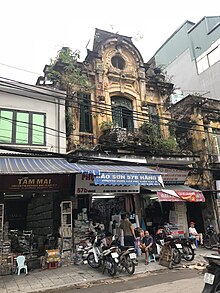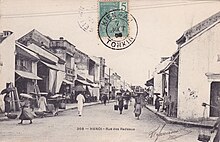| This article needs additional citations for verification. Please help improve this article by adding citations to reliable sources. Unsourced material may be challenged and removed. Find sources: "Old Quarter, Hanoi" – news · newspapers · books · scholar · JSTOR (February 2018) (Learn how and when to remove this message) |



The Old Quarter (Vietnamese: Phố cổ Hà Nội) is the name commonly given to the historical civic urban core of Hanoi, Vietnam, located outside the Imperial Citadel of Thăng Long. This quarter used to be the residential, manufacturing and commercial center, where each street was specialized in one specific type of manufacturing or commerce.
Another common name referring to approximately the same area is the 36 streets (Vietnamese: Hà Nội 36 phố phường), after the 36 streets or guilds that used to make up the urban area of the city.
Extent

The official extent of the Hanoi Old Quarter has been fixed by a 1995 decision from the Vietnamese Ministry of Construction: in the north it is limited by Hàng Đậu street, in the west by Phùng Hưng street, in the south by Hàng Bông street, Hàng Gai street, Cầu Gỗ street, and Hàng Thùng street, and in the east by Trần Quang Khải street and Trần Nhật Duật street. Several of the streets that were part of the historic urban area of Hanoi lie outside this region, which was determined for being most dense in historical streets and for having maintained its historical character best.
The official Old Quarter is part of the Hoàn Kiếm District. Its total area is about 100 ha and it counts 76 streets distributed over 10 wards.
History


The residential and commercial area that is now the Old Quarter came to be during the Lý and Trần dynasties and was then located east of the Imperial Citadel of Thăng Long and along the Red River. During the Lê dynasty, scholar Nguyễn Trãi already mentioned some of the areas each specialized in one particular trade. It was then surrounded by a defensive wall with several gates.
During the Lê dynasty, the area included several lakes and wetlands, the largest of which was Thái Cực lake. These lakes, as well as the Tô Lịch River were connected with Hoàn Kiếm lake and the Red River. Near the end of the 19th century these lakes and rivers became isolated from each other.
During the Lý and Trần dynasties, many people from the surrounding plains migrated to the city and settled in what is now the Old Quarter, creating the densest urban area of the city. The Lê dynasty period saw an additional influx of Chinese immigrants who arrived to trade, creating several Chinese neighbourhoods..
When the French ruled over Vietnam, they partially rebuilt the area. This period saw many French and Indians settling there to conduct business. Two small markets were demolished to make place for Đồng Xuân Market. Furthermore, a tramway was constructed through the quarter.
The area is still the commercial heart of Hanoi.
36 guild streets

The most famous trait of the Old Quarter are its areas dedicated to one specific trade or guild. Craftsmen from villages around the city used to gather in one area of their guild to sell their wares to merchants. The crafts or guilds of each area gave the names to the streets of the quarter, so that most streets acquired names starting with hàng ("wares"), such as Hàng Tre street ("bamboo wares street") and Hàng Đồng street ("copper wares street").
Several of the streets are still specialized in the trade that gave them their names. Others still specialize in one specific trade, but a different one from their traditional specialty — such as Hàng Buồm street ("sails street") which has become dominated by Vietnamese cakes and candy.
The Old Quarter has been shown by researchers using the quantitative social anthropology approach to have exhibited Hanoi's cultural evolution during the first decades of the 20th century.
Historical architecture

The Old Quarter contains many historic sights, such as temples, pagodas, and assembly halls.
Most craft streets used to have a temple dedicated to worshiping mythical founders of the craft. Particular is that the ground floor of such communal temples in the Hanoi Old Quarter was often still used for commerce. With the passage of time, most such communal temples have been destroyed. Several temples have survived, such as the Mã Mây and Kim Cổ temples.
Several city gates were located in what is now the Old Quarter. Only the Quan Chưởng gate is still left
Characteristic of the Old Quarter is the ancient architecture of the commercial area. Most of the historic houses there are shophouses with slanted tile roofs, of which the side facing the street used to be used as entrance to the shop inside. Houses of this type were mostly built in the 18th and 19th centuries — before that most houses had thatched roofs.
Since the end of the 20th century, the number of traditional houses have been dwindling in number.
Preservation

Many of the historic remnants of the Old Quarter have deteriorated and are in need of restoration. For the 1000th anniversary of Nội in 2010, the Hanoi People's Committee decided to spend 50 billion VND on the refurbishing of 75 streets inside and outside the Old Quarter, among others for applying lime to restore the yellow color of façades in the Old Quarter. The process has been criticised for having been executed carelessly, leading to a less than optimal result.
Vietnamese painter Bùi Xuân Phái has created many paintings of the Old Quarter, pioneering a particular school of Vietnamese painting.

Image gallery
-
 Đồng Xuân Market
Đồng Xuân Market
-
 Cờ Đen street
Cờ Đen street
-
 Hàng Nón street
Hàng Nón street
-
 Hàng Quạt street
Hàng Quạt street
-
Quán Thánh Temple
-
 Bạch Mã (White Horse) Temple
Bạch Mã (White Horse) Temple
-

-

See also
References
- Phê duyêt quy hoạch bảo vệ, tôn tạo và phát triển khu phố cổ Hà Nội (Decision by the Vietnamese Ministry of Construction 70/BXD/KT-QH) (in Vietnamese). 30 March 1995.
- Vuong, Q.-H.; Bui, Q.-K.; La, V.-P.; Vuong, T.-T.; Ho, M.-T.; Nguyen, T. H.-K.; Nguyen, H.-N.; Nghiem, P. K.-C.; Ho, M.-T. (2019). "Cultural evolution in Vietnam's early 20th century: a Bayesian networks analysis of Hanoi Franco-Chinese house designs". Social Sciences & Humanities Open. 1 (1): 100001. arXiv:1903.00817. doi:10.1016/j.ssaho.2019.100001.
- Khánh Chi (1 April 2010). "Hà Nội 'tân trang' phố cổ" [Hanoi 'refurbishes' Old Quarter]. VnExpress (in Vietnamese).
External links
| Landmarks of Hanoi | |||||||||
|---|---|---|---|---|---|---|---|---|---|
| Public space | |||||||||
| Historical monuments |
| ||||||||
| Nature and parks | |||||||||
| Religious sites |
| ||||||||
| Museums | |||||||||
| Shopping | |||||||||
| Sports | |||||||||
| Modern structures | |||||||||
| Hotels | |||||||||
| Transport | |||||||||